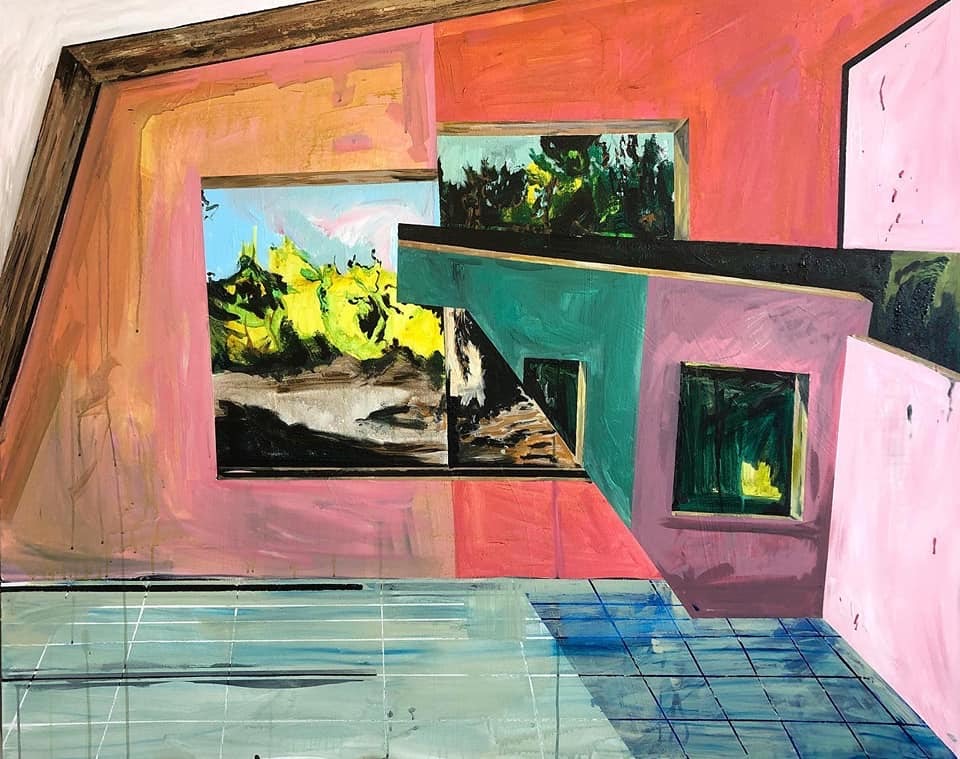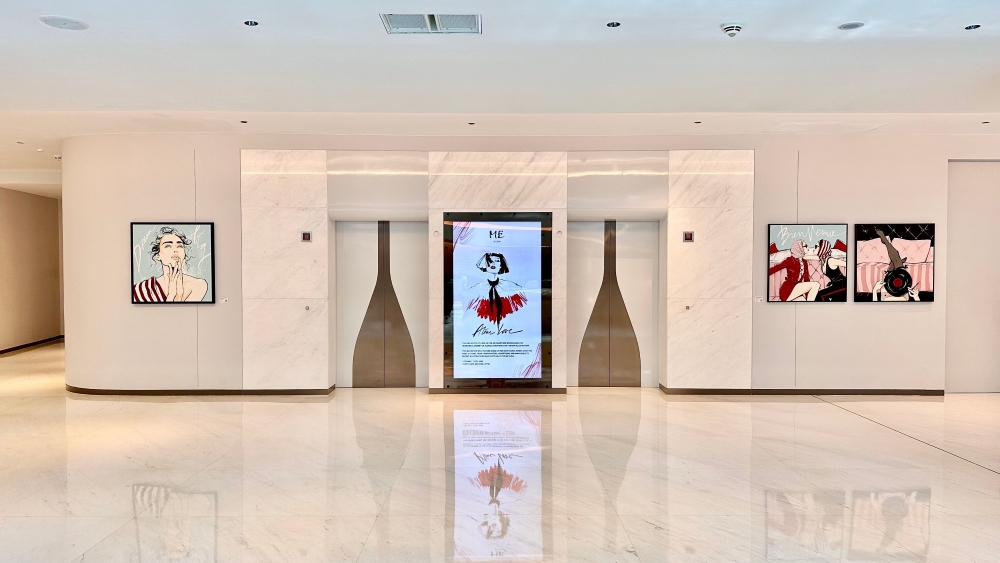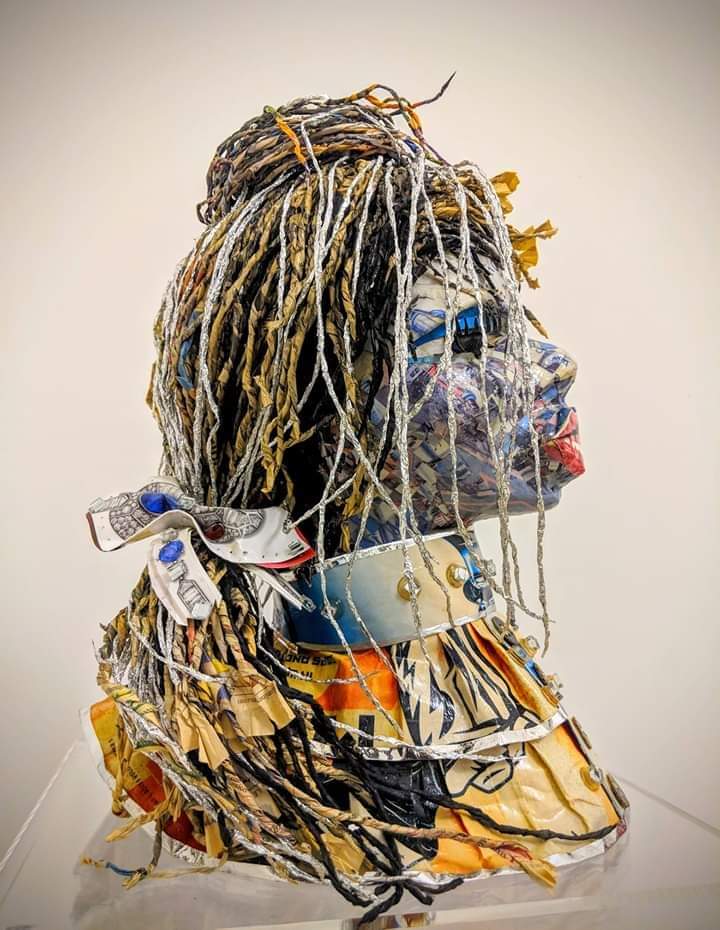The Bursting into Flame exhibition occurred from September 25 to 27 at the “Shtager&Shch” gallery, Lower Ground Floor, 52–53 Margaret Street, London. Our team attended the opening, and here’s what we think.
This exhibition was born from London’s relentless pulse — a city that devours dreams and energy, lifting as easily as it crushes. You ride in a taxi (sorry, black cab), torn between two emotions. You’re ecstatic to be in London, observing this «dream-for-art-person-city» through its streets. Despair persists, fueled by the burden of high rent and unstable income. Small talk feels like a performance, your nervous laughter betraying the tension around you. Who are you? Who were you before London? How has the city built you — and dismantled you?
The exhibition taps into this exact tension: the thin line between our public façades and private selves. It’s about that moment when you feel like you’ve regressed to adolescence, suddenly overwhelmed by long-forgotten emotions. It’s a cycle of endless despair, only to be pierced by sudden bursts of joy (thankfully, Linkin Park is performing again and we can live through it with their songs).

Stella Arion,
The moment she returns
The view of the exhibition 
Viktoriia Malysheva,
London menu
The view of the exhibition 
Sergey Borisenko,
Glass Bottle
At the entrance, Margarita Lemann’s WIND immediately pulls you in —puffins in flight, frozen against a sky that feels alive. The wind isn’t visible, but you sense it. It moves through the clouds, twisting in patterns more like calligraphy than weather, as if the sky itself is writing a poem. There’s a distinct Japanese influence here — a balance, a harmony, like those landscapes where natural forces are part of the story itself. It’s the kind of scene that stops you in your tracks, making you pause and start to understand what’s happening around you, all bound in an invisible rhythm. Puffins, when gathered in colonies, make sounds that don’t quite feel birdlike. It’s more like humans lost in some strange ecstasy, stretching out that raw “aaa-aaa-a.” Sometimes, it’s a murmur, sometimes a growl. Haven’t we felt like that? On some days, all you want is to scream with them, to join that strange choir and just let go (at least it’s valid for us). Perhaps, Margarita Lemann’s piece is the best way for an exhibition about finding yourself in London to begin.

Margarita Lemann,
Wind
The view of the exhibition 
Katia Lyubavskaya, Peace them all 
Anya Mokhova,
Pink Cosmos
Tim Antonov
Fake Language
Jang Guin Lim
Human shield
VELLY,
Suspention
Humour, of course, is not absent from the exhibition. It’s an essential element, disrupting any claim of finality. Following in the footsteps of Gillian Wearing’s Signs that Say What You Want Them to Say (1992–93), the artists in Bursting into Flame were asked to share confessions (sometimes banal, sometimes humorous) woven into their works. The exhibition is certainly centred around its core theme, but there’s still something captivating about the eclectic mix of works — whether it’s a series of quirky characters, unfamiliar languages, a sorrowful goddess Isis, faceless figures, abstract sculptures (both sharp and soft, hiding glimpses of undergarments), or figurative photography. There’s also hand-painted English china or a miniature house with a post-apocalyptic interior.

Elena Timokhina,
“Dostoevsky’s daughter monologue”
Elena Timokhina 
Gillian Wearing’s Signs that Say What You Want Them to Say
A key moment of the exhibition was the performance by Elena Timokhina, Dostoyevsky’s Daughter Monologue. In London’s art scene, having a performance at an opening feels almost obligatory — a ritual to set the stage, to intensify the air. Bathed in the red glow of neon lights, Elena stood before the audience, reading from her text The Ballerina. The piece dives deep into the role of a ballerina — how she splinters herself into countless versions of the self, fractured and multiplied, performing on stage and off it, always becoming something different. Her body is in motion, and yet her mind is elsewhere, always shifting between realities. The red glow wasn’t just atmospheric; it felt like a warning, a symbol of the emotional undercurrent that runs through this dissection. The performance echoed the city’s relentless demand for reinvention and adaptation. In London, you’re always performing — slipping into new roles, trying on new identities, but always wondering what’s left of you when the performance is over.
Timokhina’s voice added yet another layer to the exhibition — a dimension of sound. Her words cut through the gallery space, reverberating with the rawness of confession and the rhythm of performance. The soundscape wasn’t just an accompaniment; it was integral, pulling you deeper into the emotional landscape of the show.

Emmet Kierans,
Maids of Honour
Anastasiia Aleksandrenko,
The Face of Immigration
Anastasia Vandalkovskaya,
Emigrant woman
Alina Saffron,
Monster
Sila Sen,
After Humans: The Party is Over
Diana Rusyaykina,
Un/Stoppable
Let us catch fire, not to be consumed, but to burn away the false divides between self and city, between art and illusion. The works in Bursting into Flame ask us to look inward, to confess not only our hopes but our absurdities. To stop pretending we are so sure of anything. For in the end, what could be more human than to burn, to change, and to find beauty not in resolution, but in the ongoing, chaotic act of becoming?

Nataliia Ryzhova,
Being watched=being stuck
Oxana Geets,
The Weeping
Viktoriia Saifutdinova,
Talk with yourself
P.S. All the featured artists are immigrants from different countries, who arrived in London over the past 15 years, contributing their own stories to this intricate web of art, city, and self.
About the show:
Bursting into Flame, September 25-27, “Shtager&Shch” gallery, London.
Curated by Anastasia Garnova, Il Gurn.
Artists: Anastasiia Aleksandrenko, Tim Antonov, Stella Arion, Sergey Borisenko, Oxana Geets, Igor Khlopotov, Emmet Kierans, Jang Guin Lim, Margarita Lemann, Katia Lyubavskaya, Viktoriia Malysheva, Anya Mokhova, Anastasia Rak, Nataliia Ryzhova, Diana Rusyaykina, Alina Saffron, Viktoriia Saifutdinova, Sila Sen, Elena Timokhina, Anastasia Vandalkovskaya, VELLY.



